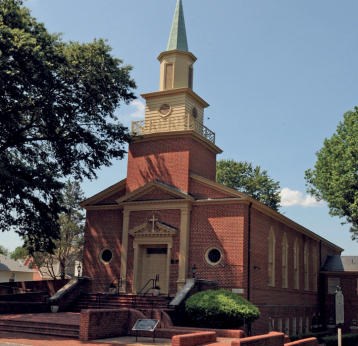WILLIAMSBURG, Va. (AP) – The brick foundation of one of the nation’s oldest Black churches has been unearthed at Colonial Williamsburg, a living history museum in Virginia that continues to reckon with its past storytelling about the country’s origins and the role of Black Americans.
The First Baptist Church was formed in 1776 by free and enslaved Black people. They initially met secretly in fields and under trees in defiance of laws that prevented African Americans from congregating.
By 1818, the church had its first building in the former colonial capital. The 16-foot by 20-foot (5-meter by 6-meter) structure was destroyed by a tornado in 1834.
First Baptist’s second structure, built in 1856, stood there for a century. But an expanding Colonial Williamsburg bought the property in 1956 and turned it into a parking lot.
First Baptist Pastor Reginald F. Davis, whose church now stands elsewhere in Williamsburg, said the uncovering of the church’s first home is “a rediscovery of the humanity of a people.” “This helps to erase the historical and social amnesia that has afflicted this country for so many years,” he said.
SOIL, ARTIFACTS ANALYSIS Colonial Williamsburg on Thursday announced that it had located the foundation after analyzing layers of soil and artifacts such as a one-cent coin.
For decades, Colonial Williamsburg had ignored the stories of colonial Black Americans. But in recent years, the museum has placed a growing emphasis on African-American history, while trying to attract more Black visitors.
The museum tells the story of Virginia’s 18th century capital and includes more than 400 restored or reconstructed buildings. More than half of the 2,000 people who lived in Williamsburg in the late 18th century were Black – and many were enslaved.
Sharing stories of residents of color is a relatively new phenomenon at Colonial Williamsburg. It wasn’t until 1979 when the museum began telling Black stories, and not until 2002 that it launched its American Indian Initiative.
First Baptist has been at the center of an initiative to reintroduce African Americans to the museum. For instance, Colonial Williamsburg’s historic conservation experts repaired the church’s long-silenced bell several years ago.
Congregants and museum archeologists are now plotting a way forward together on how best to excavate the site and to tell First Baptist’s story. The relationship is starkly different from the one in the mid-20th Century.
“Imagine being a child going to this church, and riding by and seeing a parking lot … where possibly people you knew and loved are buried,” said Connie Matthews Harshaw, a member of First Baptist. She is also board president of the Let Freedom Ring Foundation, which is aimed at preserving the church’s history.
Colonial Williamsburg had paid for the property where the church had sat until the mid-1950s, and covered the costs of First Baptist building a new church. But the museum failed to tell its story despite its rich colonial history.
“It’s a healing process … to see it being uncovered,” Harshaw said. “And the community has really come together around this. And I’m talking Black and white.”
The excavation began last year. So far, 25 graves have been located based on the discoloration of the soil in areas where a plot was dug, according to Jack Gary, Colonial Williamsburg’s director of archaeology.
1818 TAX RECORDS
Gary said some congregants have already expressed an interest in analyzing bones to get a better idea of the lives of the deceased and to discover familial connections. He said some graves appear to predate the building of the second church.
It’s unclear exactly when First Baptist’s first church was built. Some researchers have said it may already have been standing when it was offered to the congregation by Jesse Cole, a white man who owned the property at the time. First Baptist is mentioned in tax records from 1818 for an adjacent prop. erty.













No Comment